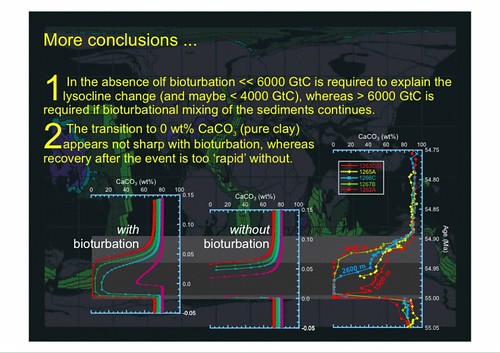Had a visit from Andy Ridgwell and his postdoc Jenny Brauch last week. They weren't visiting me, but rather jules and the other paleoclimatologists around here. Andy is doing biogeochemical and sedimentary things with the GENIE model, and our ensemble Kalman Filter is proving to be a very powerful model tuning tool. I went along to some seminars to learn a little...
One thing that fossil fuel combustion will mean is a lot more CO2 disolved in the ocean, and this leads to less calcium carbonate (CaCO3) deposition in sediments (and even dissolution of what is already deposited in the upper sediment layers). Evidence of this can be seen in the past (eg PETM), when there is also a spike in carbon isotopes suggesting a big release of some old carbon (potentially methane clathrates). Andy's been simulating what might have happened, using a biogeochemical and sediment model embedded in the atmosphere/ocean system.
He's got some really impressive results in the pipeline (being written up), and here is a sneak preview:
 The RH lines are plots of carbonate concentration from actual cores, and the two LH plots are simulations under slightly different conditions. One interesting detail in the far LH plot is that the spike appears to start at a different time in the purple core. This is actually because the carbonate is eroded down further in the other cores, eating back in time and erasing the sediment record. It does make me wonder at the precision of core dating, since generally spikes in different cores are assumed to be simultaneous and so are lined up (of course the scientists concerned are well aware of the problems). This is the sort of thing that can only really be investigated by "forward modelling of proxies" (increasingly fashionable these days) in which the proxy creation is embedded into the model itself, rather than the old traditional approach of inverting the proxy into climate variables, and then comparing these variables to your model.
The RH lines are plots of carbonate concentration from actual cores, and the two LH plots are simulations under slightly different conditions. One interesting detail in the far LH plot is that the spike appears to start at a different time in the purple core. This is actually because the carbonate is eroded down further in the other cores, eating back in time and erasing the sediment record. It does make me wonder at the precision of core dating, since generally spikes in different cores are assumed to be simultaneous and so are lined up (of course the scientists concerned are well aware of the problems). This is the sort of thing that can only really be investigated by "forward modelling of proxies" (increasingly fashionable these days) in which the proxy creation is embedded into the model itself, rather than the old traditional approach of inverting the proxy into climate variables, and then comparing these variables to your model.
In the next few centuries, I suppose we'll erase the past 10-100,000 years of carbonate history. I wonder what the androids alive 50 million years from now will think of it. In terms of climate change it is somewhat helpful, as the carbonate ions neutralise the aqueous CO2, increasing the ocean's capacity to dissolve CO2 (somewhat counterintuitive to numpties like me that the carbonate erosion helps things, but even though the total load of dissolved carbon increases, the CO2 and CO3(2-) together with an H20 make two HCO3(-) ions which do not exchange with the atmosphere). It's not a massive effect, though, and the bugs that try to make CaCO3 might not like the increased acidity much.
 It wasn't all work and no fun - as well as a trip to Tokyo (which we had to do anyway, for this), we showed them round Kamakura. Andy is a vegetarian, and Japan isn't the easiest place to find good vegetarian food. So he was happy to be taken to the shojin-ryouri restaurant just outside Kenchoji temple. I'm not sure that the beer is strictly Buddhist, but neither are we :-)
It wasn't all work and no fun - as well as a trip to Tokyo (which we had to do anyway, for this), we showed them round Kamakura. Andy is a vegetarian, and Japan isn't the easiest place to find good vegetarian food. So he was happy to be taken to the shojin-ryouri restaurant just outside Kenchoji temple. I'm not sure that the beer is strictly Buddhist, but neither are we :-)
(T-side also does a lot of veggie food - we went there for dinner)
One thing that fossil fuel combustion will mean is a lot more CO2 disolved in the ocean, and this leads to less calcium carbonate (CaCO3) deposition in sediments (and even dissolution of what is already deposited in the upper sediment layers). Evidence of this can be seen in the past (eg PETM), when there is also a spike in carbon isotopes suggesting a big release of some old carbon (potentially methane clathrates). Andy's been simulating what might have happened, using a biogeochemical and sediment model embedded in the atmosphere/ocean system.
He's got some really impressive results in the pipeline (being written up), and here is a sneak preview:
 The RH lines are plots of carbonate concentration from actual cores, and the two LH plots are simulations under slightly different conditions. One interesting detail in the far LH plot is that the spike appears to start at a different time in the purple core. This is actually because the carbonate is eroded down further in the other cores, eating back in time and erasing the sediment record. It does make me wonder at the precision of core dating, since generally spikes in different cores are assumed to be simultaneous and so are lined up (of course the scientists concerned are well aware of the problems). This is the sort of thing that can only really be investigated by "forward modelling of proxies" (increasingly fashionable these days) in which the proxy creation is embedded into the model itself, rather than the old traditional approach of inverting the proxy into climate variables, and then comparing these variables to your model.
The RH lines are plots of carbonate concentration from actual cores, and the two LH plots are simulations under slightly different conditions. One interesting detail in the far LH plot is that the spike appears to start at a different time in the purple core. This is actually because the carbonate is eroded down further in the other cores, eating back in time and erasing the sediment record. It does make me wonder at the precision of core dating, since generally spikes in different cores are assumed to be simultaneous and so are lined up (of course the scientists concerned are well aware of the problems). This is the sort of thing that can only really be investigated by "forward modelling of proxies" (increasingly fashionable these days) in which the proxy creation is embedded into the model itself, rather than the old traditional approach of inverting the proxy into climate variables, and then comparing these variables to your model.In the next few centuries, I suppose we'll erase the past 10-100,000 years of carbonate history. I wonder what the androids alive 50 million years from now will think of it. In terms of climate change it is somewhat helpful, as the carbonate ions neutralise the aqueous CO2, increasing the ocean's capacity to dissolve CO2 (somewhat counterintuitive to numpties like me that the carbonate erosion helps things, but even though the total load of dissolved carbon increases, the CO2 and CO3(2-) together with an H20 make two HCO3(-) ions which do not exchange with the atmosphere). It's not a massive effect, though, and the bugs that try to make CaCO3 might not like the increased acidity much.
 It wasn't all work and no fun - as well as a trip to Tokyo (which we had to do anyway, for this), we showed them round Kamakura. Andy is a vegetarian, and Japan isn't the easiest place to find good vegetarian food. So he was happy to be taken to the shojin-ryouri restaurant just outside Kenchoji temple. I'm not sure that the beer is strictly Buddhist, but neither are we :-)
It wasn't all work and no fun - as well as a trip to Tokyo (which we had to do anyway, for this), we showed them round Kamakura. Andy is a vegetarian, and Japan isn't the easiest place to find good vegetarian food. So he was happy to be taken to the shojin-ryouri restaurant just outside Kenchoji temple. I'm not sure that the beer is strictly Buddhist, but neither are we :-)(T-side also does a lot of veggie food - we went there for dinner)
5 comments:
Fascinating stuff! Too late for the AR4, I assume? And now you've ruined their chances for publication. I hope you at least popped for the food. :)
Dear James:
What is a numptie? (If it's a dumb question, I apologize in advance, but how will I know if I don't ask?)
Steve,
No respectable journal will care about such an obscure pre-publication. I guess the weekly tabloids could in principle object to it, but this bit of work wasn't aimed at them anyway.
Kit,
this may be helpful, ya great numpty :-)
Probably the remnants of my scottish heritage...
Great word! Don't think I'll be able to get much use out of in CA, though...
numpty pumpty pat on a fall
Cool Ideas, but what about the future of our beloved RNA and DNA, sulfur soups in caves, and also silicon based life forms?
Post a Comment